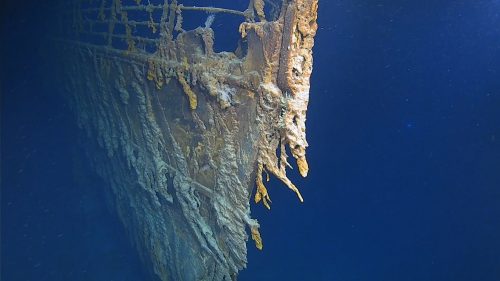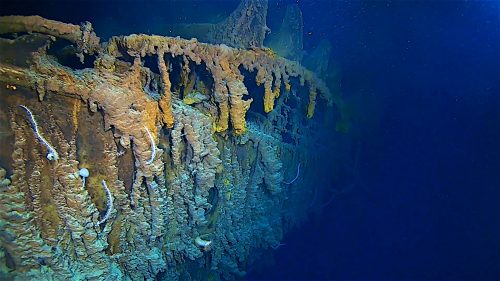For the first time in 14 years, the RMS Titanic wreck has been revisited: a manned submersible reached the bottom of the North Atlantic Ocean (3,810 meters/12,500 feet) in a ground-breaking expedition in early August. A renowned deep-ocean exploration team led by explorer Victor Vescovo, Titanic expert Parks Stephenson, expedition leader Rob McCallum (EYOS Expeditions), and a technical team from Triton Submarines surveyed the wreck of the RMS Titanic. The team deployed an advanced, two-person full ocean depth submergence vehicle: the cutting-edge Triton 36,000/2 named the DSV Limiting Factor. A total of five dives to the wreck were made over eight days at the Titanic’s final resting place 370 miles south of Newfoundland, Canada.
Following established U.S. legal protocols and under the observation of an on-board NOAA representative, the team of experts and scientists examined the remains of the ship, capturing for the first time extraordinary native 4K footage using specially adapted cameras, to capture the wreck in a way it’s never been seen before. Using the submersible camera systems, the team performed dedicated photogrammetry passes on the wreck, allowing highly accurate and photoreal 3D models of RMS Titanic to be produced. These assets will help assess the wreck’s current condition and project it’s future, as well as making it possible to visualise the wreck using augmented reality (AR) and virtual reality (VR) technology.
The scientists of the expedition will publish the full results alongside a documentary film being made by BAFTA and Emmy award-winning Atlantic Productions, London.
Lying almost 4,000 meters down in bitterly cold 1°C water, the wreck has become vulnerable from sweeping eddies and subjected to ever-changing sea currents. Salt corrosion, metal-eating bacteria and deep current action are having the greatest impact on the wreck. The team observed one area of deterioration was in the officer’s quarters, where the captain had his rooms. Here the hull has started to collapse, taking with it the staterooms. Whilst on the site, the team laid a wreath and held a short ceremony in honour of those who lost their lives in 1912.
Parks Stephenson, Titanic Historian “The most shocking area of deterioration was the starboard side of the officer’s quarters, where the captain’s quarters were. Captain’s bath tub is a favourite image among the Titanic enthusiasts, and that’s now gone. That whole deck hole on that side is collapsing taking with it the staterooms, and the deterioration is going to continue advancing.”
Victor Vescovo, CEO of Caladan Oceanic and Submersible pilot “It’s a big wreck, I wasn’t quite prepared for how large it was. It was extraordinary to see it all, and the most amazing moment came when I was going along the side of the Titanic and the bright lights of the submersible reflected off a portal and came right back, it was like the ship was winking at me. It was amazing.”
Lori Johnson, Scientist “The future of the wreck is going to continue to deteriorate over time, it’s a natural process. These are natural types of bacteria, so the reason that the deterioration process ends up being quite a bit faster, is a group of bacteria, a community working symbiotically to eat, if you will the Iron and the sulphur.”











